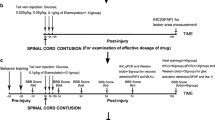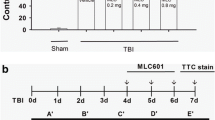Abstract
Expansion of the secondary injury following primary spinal cord injury is a major pathological event that increases destruction in the spinal cord, so measures to reduce secondary injury are needed. Our previous study demonstrated that, at the front of the expanding secondary injury in the spinal cord, there is an ischemic area in which many neurons can still be rescued. Therefore, enhancement of blood circulation in the cord may be helpful, and indeed, we found that a traditional Chinese medicine, shu-xue-tong, efficiently reduces the secondary injury. The aim of the present study was to investigate the effect of reducing fibrinogen with Batroxobin, a drug widely used clinically for ischemia, in rats with spinal cord contusion. We found that both 2 and 4 Batroxobin units (BU)/kg efficiently decreased the plasma fibrinogen, and 2 BU/kg significantly increased spinal blood flow, enhanced neuronal survival, mitigated astrocyte and microglia activation, and improved locomotor recovery. However, 4 BU/kg had no effect on the secondary spinal cord injury. These data suggest that Batroxobin has multiple beneficial effects on spinal cord injury, indicating a potential clinical application.
Similar content being viewed by others
References
Cao HQ, Dong ED. An update on spinal cord injury research. Neurosci Bull 2013, 29:94–102.
Mautes AE, Weinzierl MR, Donovan F, Noble LJ. Vascular events after spinal cord injury: contribution to secondary pathogenesis. Phys Ther 2000, 80:673–687.
Kwon BK, Tetzlaff W, Grauer JN, Beiner J, Vaccaro AR. Pathophysiology and pharmacologic treatment of acute spinal cord injury. Spine J 2004, 4:451–464.
Martirosyan NL, Feuerstein JS, Theodore N, Cavalcanti DD, Spetzler RF, Preul MC. Blood supply and vascular reactivity of the spinal cord under normal and pathological conditions. J Neurosurg Spine 2011, 15:238–251.
Takigawa T, Yonezawa T, Yoshitaka T, Minaguchi J, Kurosaki M, Tanaka M, et al. Separation of the perivascular basement membrane provides a conduit for inflammatory cells in a mouse spinal cord injury model. J Neurotrauma 2010, 27:739–751.
Norenberg MD, Smith J, Marcillo A. The pathology of human spinal cord injury: defining the problems. J Neurotrauma 2004, 21:429–440.
Popa C, Popa F, Grigorean VT, Onose G, Sandu AM, Popescu M, et al. Vascular dysfunctions following spinal cord injury. J Med Life 2010, 3:275–285.
Tator CH, Fehlings MG. Review of the secondary injury theory of acute spinal cord trauma with emphasis on vascular mechanisms. J Neurosurg 1991, 75:15–26.
Shen XF, Zhao Y, Zhang YK, Jia LY, Ju G. A modified ferric tannate method for visualizing a blood vessel and its usage in the study of spinal cord injury. Spinal Cord 2009, 47:852–856.
Johnson SH, Kraimer JM, Graeber GM. Effects of flunarizine on neurological recovery and spinal cord blood flow in experimental spinal cord ischemia in rabbits. Stroke 1993, 24:1547–1553.
Jia LY, Yao AH, Kuang F, Zhang YK, Shen XF, Ju G. Beneficial effect of the traditional chinese drug shu-xuetong on recovery of spinal cord injury in the rat. Evid Based Complement Alternat Med 2011, 2011.
Blomback B. Fibrin formation in whole blood. Thromb Res 2000, 99:307–310.
Schachtrup C, Ryu JK, Helmrick MJ, Vagena E, Galanakis DK, Degen JL, et al. Fibrinogen triggers astrocyte scar formation by promoting the availability of active TGF-beta after vascular damage. J Neurosci 2010, 30:5843–5854.
Davalos D, Ryu JK, Merlini M, Baeten KM, Le Moan N, Petersen MA, et al. Fibrinogen-induced perivascular microglial clustering is required for the development of axonal damage in neuroinflammation. Nat Commun 2012, 3:1227.
You WK, Choi WS, Koh YS, Shin HC, Jang Y, Chung KH. Functional characterization of recombinant batroxobin, a snake venom thrombin-like enzyme, expressed from Pichia pastoris. FEBS Lett 2004, 571:67–73.
Bell WR Jr. Defibrinogenating enzymes. Drugs 1997, 54(Suppl 3):18–30; discussion 30–31.
Gusev EI, Skvortsova VI, Suslina ZA, Avakian GN, Martynov M, Temirbaeva SL, et al. Batroxobin in patients with ischemic stroke in the carotid system (the multicenter study). Zh Nevrol Psikhiatr Im S S Korsakova 2006, 106:31–34.
Shiraishi T, Kubo T, Matsunaga T. Chronological study of recovery of sudden deafness treated with defibrinogenation and steroid therapies. Acta Otolaryngol 1991, 111:867–871.
Plemel JR, Duncan G, Chen KW, Shannon C, Park S, Sparling JS, et al. A graded forceps crush spinal cord injury model in mice. J Neurotrauma 2008, 25:350–370.
Scheff SW, Saucier DA, Cain ME. A statistical method for analyzing rating scale data: the BBB locomotor score. J Neurotrauma 2002, 19:1251–1260.
Zhu H, Feng YP, Young W, You SW, Shen XF, Liu YS, et al. Early neurosurgical intervention of spinal cord contusion: an analysis of 30 cases. Chin Med J (Engl) 2008, 121:2473–2478.
Adams RA, Passino M, Sachs BD, Nuriel T, Akassoglou K. Fibrin mechanisms and functions in nervous system pathology. Mol Interv 2004, 4:163–176.
Author information
Authors and Affiliations
Corresponding author
Rights and permissions
About this article
Cite this article
Fan, H., Liu, X., Tang, HB. et al. Protective effects of Batroxobin on spinal cord injury in rats. Neurosci. Bull. 29, 501–508 (2013). https://doi.org/10.1007/s12264-013-1354-7
Received:
Accepted:
Published:
Issue Date:
DOI: https://doi.org/10.1007/s12264-013-1354-7




